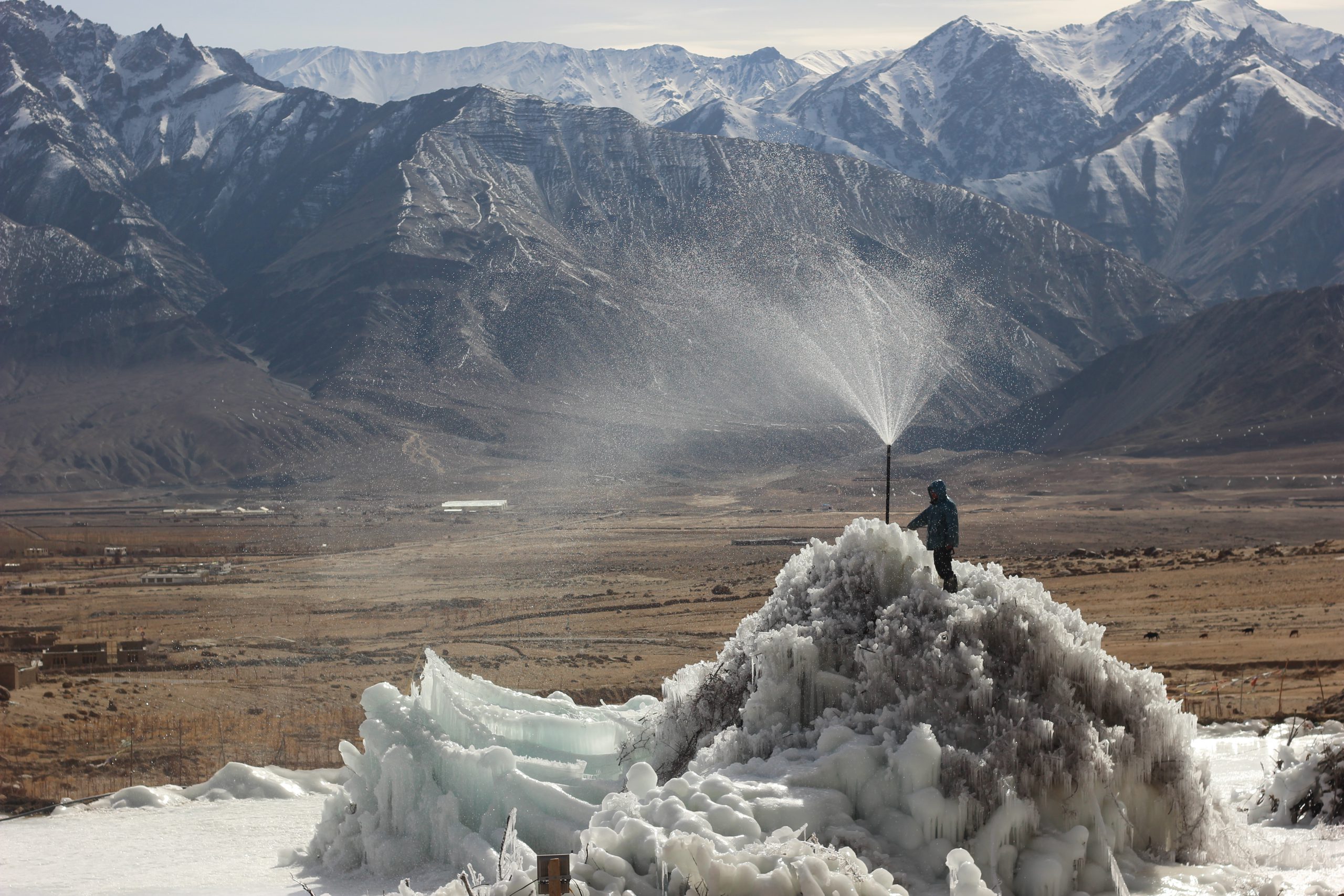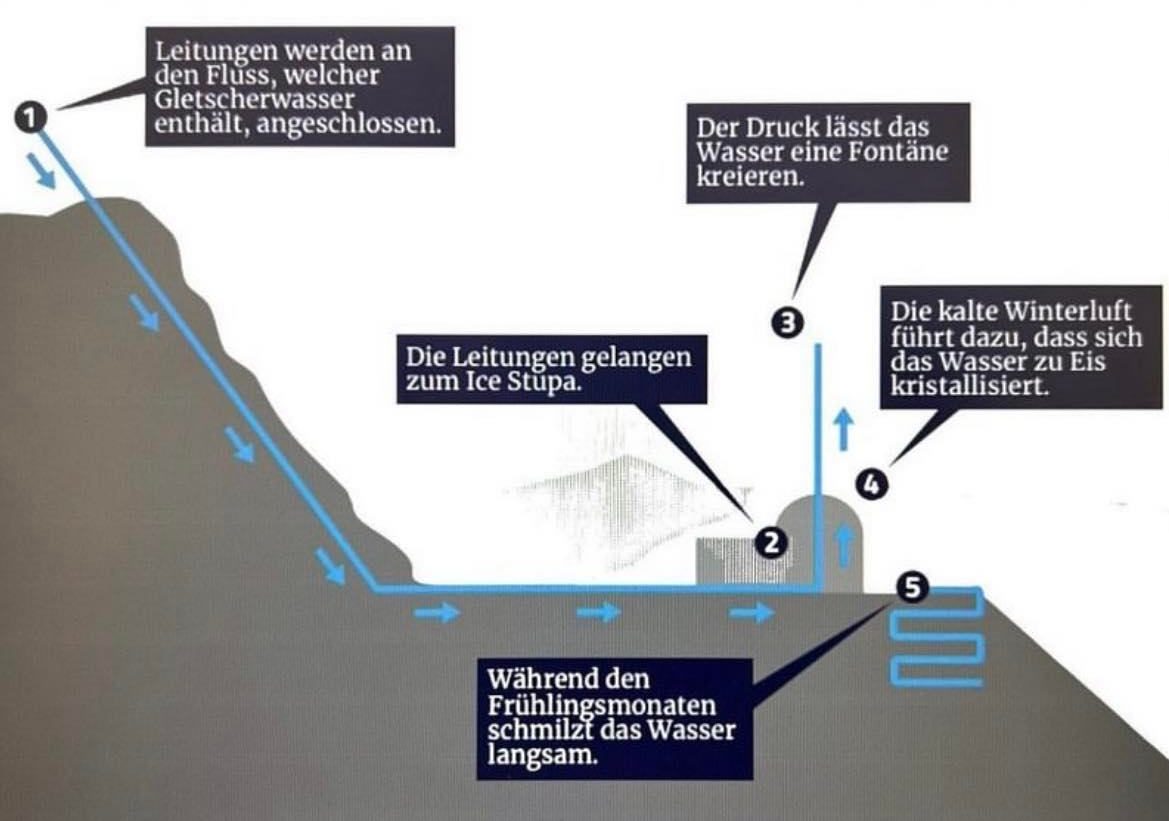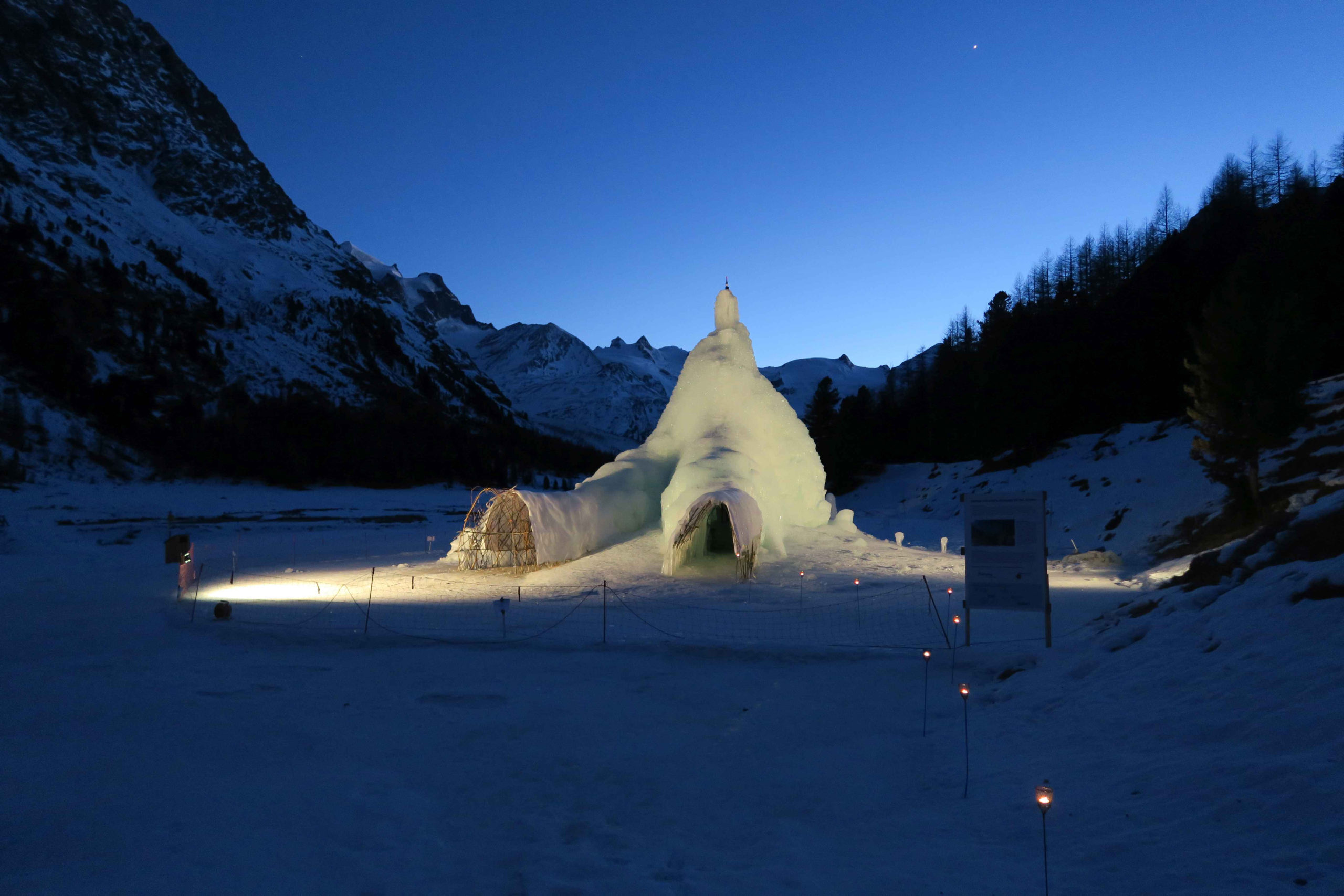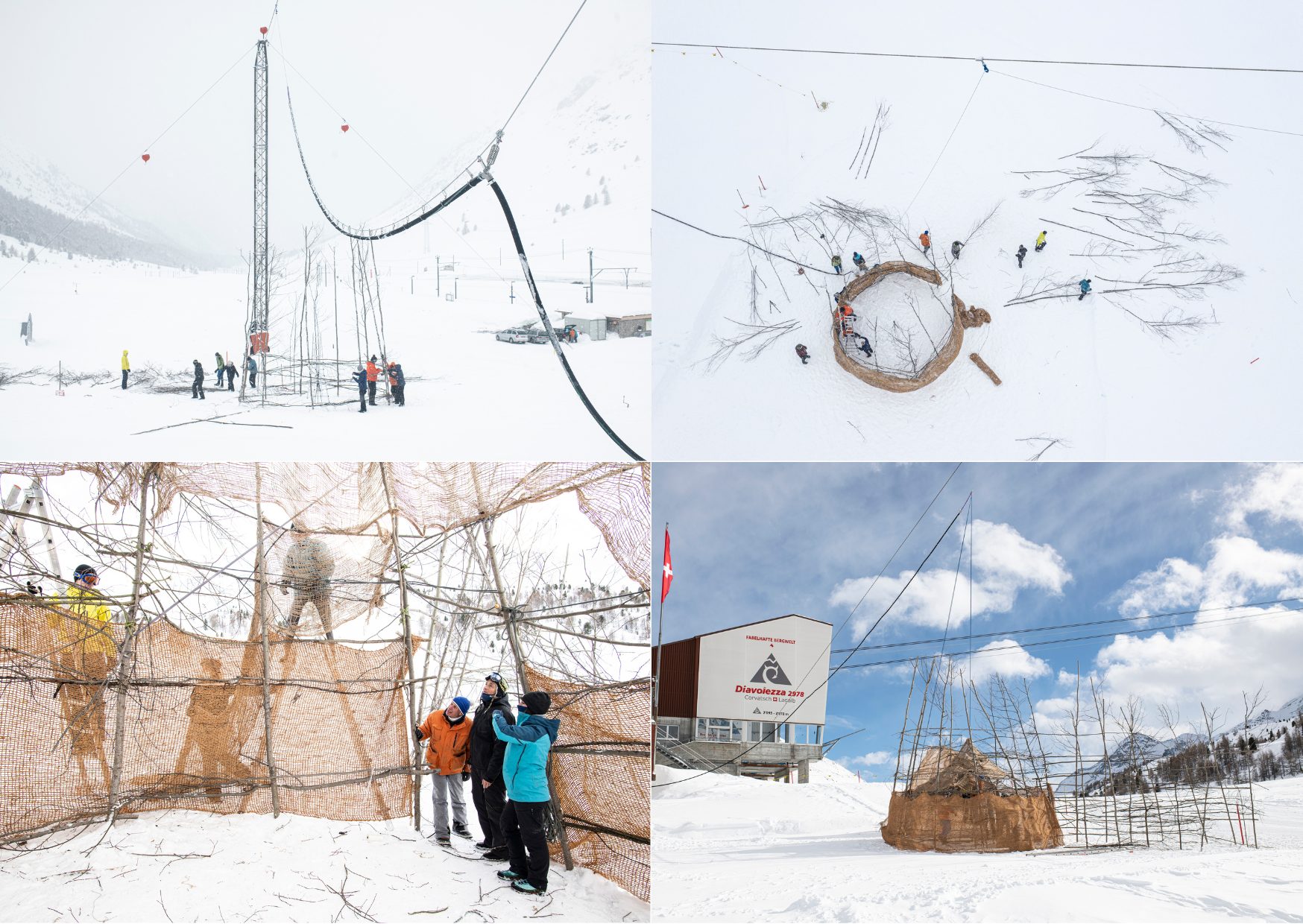PROJECTS
The association GlaciersAlive is involved in various forms of projects to to find sustainable solutions to water issues in mountain regions.
The mountains are globally significant water castles. They provide freshwater for about half of the earth's population for irrigation, industry, domestic use and power generation. At the same time, the mountains are among the most climate-sensitive regions. Mountain populations are already exposed to climate change and are therefore forced to take adaptationmeasures.
Worldwide glacier retreat is one of the clearest and most impressive signals of climate change. On a regional level, glacier changes affect the landscape, water runoff (storage function, irrigation), natural hazards (ice avalanches, outburst floods) and the tourism industry (ski resorts, landscape attractiveness).
Ice Stupas in Ladakh

Ice Stupa Projekt 23/24
Im Winter 2023 wurde ein neues Ice Stupa Projekt gestartet. Das Ziel? Der größte Ice Stupa in Europa zu werden. Der Ice Stupa ist stand 26.02.24 14 Meter hoch und wenn das Wetter mitspielt, soll der Ice Stupa bis zu 20 Meter hoch werden. Dieses Projekt kann dank dem von der Hochschule Luzern entwickelten automatischen Steuerungssystem und der Initiative des Vereins GlaciersAlive, der Gletschervision GmbH, the Diavolezza cable car, Go Vertical and BerninaGlaciers. The Ice Stupa has been installed at the Diavolezza valley station since November and can be viewed there. The Ice Stupa is designed as a huge, unmissable ice sculpture with an interior full of icicles that can be used for mini-events, drinks receptions and guided tours. In addition, the Cover Project Foundation is conducting a targeted fundraising campaign for the benefit of communities in need of water in Ladakh.

MortAlive
MortAlive ist ein Projekt mit dem Ziel innovative Lösungen für das Abdecken von Gletschern mit Schnee zu finden. Solange Schnee auf dem Eis liegt, ist dies vollständig vor dem Schmelzen geschützt. Somit könnte der Verlust von Wasser-speichern, in trockenen Gebirgsregionen gestoppt werden. Learn more

The Morteratsch glacier
The Morteratsch glacier is the largest glacier in the Bernina chain in terms of area. Annual length change measurements have been recorded since 1878. In addition, Johannes Oerlemans and his team have been making annual energy balance measurements on the glacier tongue since 1995. The numbers show that the glacier has retreated by more than 3 kilometers in the last 60 years.

Preserve the glaciers
According to model calculations with a climate scenario of 0.022 °C temperature increase per year and a year-round snow-covered area of 0.8 km2 , it could be calculated that under today's conditions even glacier growth (length increase) would be possible in 10 years if 10% of the glacier area were covered with snow all year round.
A large amount of the glacier's meltwater could be collected at high altitude, recycled in the form of snow and thus returned to the glacier. This would require glacier meltwater, a jet pump, sufficient water pressure and sophisticated technology for snow production without electricity.
The innovative snowmaking system is currently manufactured by two Swiss companies. Bartholet Maschinenbau AG is the world's leading manufacturer of ropeway systems. The company Bachler Top Track AG also holds a patent for the "Nessy" system, which enables snow production without electricity.

NESSy ZeroE Snow Lances
With the Swiss patented "Nessy" system it is possible to produce snow without electrical energy. Only 200 meters of height difference between the water source and the snow cable are necessary to generate the required pressure of 20 bar in the water pipe.
A single NESSy ZeroE (NESSy = New Energy Efficient Snow System) can cover an area of 200 to 400m 2 during the summer months. The water required for this could be taken from a future meltwater lake of the Pers Glacier, which lies 200m above the area to be covered with snow.

Glacier protection worldwide
If enough snow can be produced by meltwater recycling to keep 10% of the Morteratsch glacier covered with snow in summer, the glacier would be protected from melting. Under today's climatic conditions, the length would even increase again after 10 years.
This would make it the first alpine glacier to advance in decades and could ensure water availability in the Engadine in the long term even in very dry heat summers.
The project would represent a breakthrough for freshwater storage worldwide. The water supply in Leh (Ladakh, northern India), for example, depends on a glacier that will disappear in the next few years. The installation of the ground-independent snowmaking system could protect the glacier and thus also the drinking water supply of the capital of this region.
The figure on the left shows in white all the places where such a snowmaking system could secure the drinking water supply for the population.

Fleece cover
The material used to cover the glaciers must be durable, resist harsh elements/time, and be white to reflect and insulate the sun's rays. Fleece covers are one of the only successfully implemented methods to preserve snow and glaciers by protecting the snow below from melting.
Solar radiation is reflected by the white material and on average 50-60% of the snow underneath can be conserved. Fleece covers are already in use at various ski resorts. On the Diavolezza glacier in the Upper Engadine in Switzerland, they have been used successfully for more than 10 years.
The fleece used on the Diavolezza is made of polypropylene, a thermoplastic polymer that can be 100% recycled material and lasts up to 5 years.
We are seeking an investigation to find a more sustainable and ecological material that has the same or better technical advantages than the current one.

Ice Stupa Project
With the "Ice Stupa Artifical Ice Reservoir Technology" (AIR), unused water is stored in large ice towers in winter. The meltwater available in spring is used for irrigation in agriculture. Learn more
The association GlaciersAlive cooperates with the Himalayan Institute of Alternatives in Ladakh. The HIAL aims to engage youth from several Himalayan countries in research and development to address the problems of mountain people, particularly in the areas of education, culture and the environment.

Inventor of the Ice Stupas
The invention of the Ice Stupas is due to the engineer Sonam Wangchuk from Ladakh. He developed the simple solution to form cone-shaped ice mounds from the melting water of the glaciers. Wangchuck's design is based on the experiments of engineer Chewang Norphel, who created flat glaciers. Why did Wangchuck choose cone-shaped rather than flat glaciers? He concluded that conical ice mounds have the least surface area and therefore melt more slowly than flat ice fields. In 2014, the built prototype provided about 1.5 million liters of meltwater for irrigation of 5000 trees planted by locals.

How does an Ice Stupa work?
The melting glacier water reaches the Ice Stupa through pipes connected to the river. The pressure generated creates a fountain that causes the water to drip onto the stupa from above. Thanks to the cold winter air, the water crystallizes into ice. Finally, the ice melts slowly in the spring months.

Europa’s erster Ice Stupa
This was built in 2016 in Val Roseg (Samedan, Pontresina). At the end of October 2016, the inventor of the Ice Stupas, the engineer Sonam Wangchuk from Ladakh, traveled to the Engadine to build the first Ice Stupa together with local glaciologists and architects.

Ice Stupa test facility at the Diavolezza
On February 11, 2021, the new snow rope and ice stupa test facility at the Diavolezza valley station in the Upper Engadine was put into operation for the first time.

Ice Stupa progress since 2021
Ice Stupa Technology has struggled with freezing problems on water lines in recent years. Once frozen, water pipes are almost impossible to get free.
Last winter, the irrigation system of the Ice-Stupa could be improved. For this purpose, small heaters were installed on the water pipes at the very cold exposed places of the Ice-Stupa, in order to ensure that all important places are free of ice before switching on. Furthermore, thanks to the heaters, it can be ensured that all water is out when emptying (switching off) and thus no ice forms in the pipes. Due to the expansion of the irrigation system, there has not been a single malfunction.

Cover Project Foundation
The Cover Project Foundation works with scientists and universities to preserve glaciers as freshwater reservoirs around the world. Learn more
Ice Stupas in Ladakh
Ice Stupa Project 2023/24
A new Ice Stupa project was launched in winter 2023. The goal? To become the largest Ice Stupa in Europe. As of 26.02.24, the Ice Stupa is 14 meters high and if the weather cooperates, the Ice Stupa is set to reach a height of 20 meters. This project can be realized thanks to the automatic control system developed by the Lucerne University of Applied Sciences and Arts and the initiative of the GlaciersAlive association, the Gletschervision GmbH, the Diavolezza cable car, Go Vertical and BerninaGlaciers. The Ice Stupa has been on display at the Diavolezza valley station since November and can be visited there. The Ice Stupa is designed as a huge, unmissable ice sculpture with an interior full of icicles that can be used for mini-events, drinks receptions and guided tours. In addition, the Cover project Foundation is conducting a targeted fundraising campaign for the benefit of communities in need of water in Ladakh.
The MortAlive Project
MortAlive
MortAlive is a project with the goal of finding innovative solutions for covering glaciers with snow. As long as snow is on the ice, this is completely protected from melting.
Thus, the loss of water reservoirs in dry mountain regions could be stopped. Learn more
The Morteratsch glacier
The Morteratsch glacier is the largest glacier in the Bernina chain in terms of area. Annual length change measurements have been recorded since 1878. In addition, Johannes Oerlemans and his team have been making annual energy balance measurements on the glacier tongue since 1995. The numbers show that the glacier has retreated by more than 3 kilometers in the last 60 years.
Preserve the glaciers
According to model calculations with a climate scenario of 0.022 °C temperature increase per year and a year-round snow-covered area of 0.8 km2 , it could be calculated that under today's conditions even glacier growth (length increase) would be possible in 10 years if 10% of the glacier area were covered with snow all year round.
A large amount of the glacier's meltwater could be collected at high altitude, recycled in the form of snow and thus returned to the glacier. This would require glacier meltwater, a jet pump, sufficient water pressure and sophisticated technology for snow production without electricity.
The innovative snowmaking system is currently manufactured by two Swiss companies. Bartholet Maschinenbau AG is the world's leading manufacturer of ropeway systems. The company Bachler Top Track AG also holds a patent for the "Nessy" system, which enables snow production without electricity.
NESSy ZeroE Snow Lances
With the Swiss patented „Nessy“-System it is possible to produce snow without electrical energy. Only 200 meters of height difference between the water source and the snow cable are required to generate the necessary pressure of 20 bar in the water pipe.
A single NESSy ZeroE (NESSy = New Energy Efficient Snow System) can cover an area of 200 to 400m 2 during the summer months. The water required for this could be taken from a future meltwater lake of the Pers Glacier, which lies 200m above the area to be covered with snow.
Glacier protection worldwide
If enough snow can be produced by meltwater recycling to keep 10% of the Morteratsch glacier covered with snow in summer, the glacier would be protected from melting. Under today's climatic conditions, the length would even increase again after 10 years.
This would make it the first alpine glacier to advance in decades and could ensure water availability in the Engadine in the long term even in very dry heat summers.
The project would represent a breakthrough for freshwater storage worldwide. The water supply in Leh (Ladakh, northern India), for example, depends on a glacier that will disappear in the next few years. The installation of the ground-independent snowmaking system could protect the glacier and thus also the drinking water supply of the capital of this region.
The figure on the left shows in white all the places where such a snowmaking system could secure the drinking water supply for the population.
Fleece cover
The material used to cover the glaciers must be durable, resist harsh elements/time, and be white to reflect and insulate the sun's rays. Fleece covers are one of the only successfully implemented methods to preserve snow and glaciers by protecting the snow below from melting.
Solar radiation is reflected by the white material and on average 50-60% of the snow underneath can be conserved. Fleece covers are already in use at various ski resorts. On the Diavolezza glacier in the Upper Engadine in Switzerland, they have been used successfully for more than 10 years.
The fleece used on the Diavolezza is made of polypropylene, a thermoplastic polymer that can be 100% recycled material and lasts up to 5 years.
We are seeking an investigation to find a more sustainable and ecological material that has the same or better technical advantages than the current one.
Ice Stupa Project
Ice Stupa Project
With the "Ice Stupa Artifical Ice Reservoir Technology" (AIR), unused water is stored in large ice towers in winter. The meltwater available in spring is used for irrigation in agriculture. Learn more
The association GlaciersAlive cooperates with the Himalayan Institute of Alternatives in Ladakh. The HIAL aims to engage youth from several Himalayan countries in research and development to address the problems of mountain people, particularly in the areas of education, culture and the environment.
Inventor of the Ice Stupas
The invention of the Ice Stupas is due to the engineer Sonam Wangchuk from Ladakh. He developed the simple solution to form cone-shaped ice mounds from the melting water of the glaciers. Wangchuck's design is based on the experiments of engineer Chewang Norphel, who created flat glaciers. Why did Wangchuck choose cone-shaped rather than flat glaciers? He concluded that conical ice mounds have the least surface area and therefore melt more slowly than flat ice fields. In 2014, the built prototype provided about 1.5 million liters of meltwater for irrigation of 5000 trees planted by locals.
How does an Ice Stupa work?
The melting glacier water reaches the ice stupa via pipes connected to the river. The pressure generated creates a fountain that causes the water to drip onto the stupa from above. Thanks to the cold winter air, the water crystallizes into ice. Finally, the ice slowly melts in the spring months.
Europe's first Ice Stupa
This was built in 2016 in Val Roseg (Samedan, Pontresina). At the end of October 2016, the inventor of the Ice Stupas, the engineer Sonam Wangchuk from Ladakh, traveled to the Engadine to build the first Ice Stupa together with local glaciologists and architects.
Ice Stupa test facility at the Diavolezza
On February 11, 2021, the new snow rope and ice stupa test facility at the Diavolezza valley station in the Upper Engadine was put into operation for the first time.
Ice Stupa progress since 2021
Ice Stupa Technology has struggled with freezing problems on water lines in recent years. Once frozen, water pipes are almost impossible to get free.
Last winter, the irrigation system of the Ice-Stupa could be improved. For this purpose, small heaters were installed on the water pipes at the very cold exposed places of the Ice-Stupa, in order to ensure that all important places are free of ice before switching on. Furthermore, thanks to the heaters, it can be ensured that all water is out when emptying (switching off) and thus no ice forms in the pipes. Due to the expansion of the irrigation system, there has not been a single malfunction.
Cover Project Foundation
Cover Project Foundation
The Cover Project Foundation works with scientists and universities to preserve glaciers as freshwater reservoirs around the world. Learn more
